Abstract
The CuZn superoxide dismutases (SODs) from ox, sheep, pig and yeast were investigated by pulse radiolysis in order to evaluate the role of electrostatic interactions between O2.- and SOD proteins in the mechanism of action of the SOD enzymes. The protein net charge in this series varies, as evaluated by the protein pI values spanning over a large range of pH: 8.0 (sheep), 6.5 (pig), 5.2 (ox) and 4.6 (yeast). The amino acid sequences are largely conserved, with the three mammalian proteins being highly homologous and the yeast protein having some distinct variations in the region surrounding the active site. At pH 8.0 the activities of the SODs from various sources are similar, though the minor differences observed suggest that in the highly homologous mammalian series the most acidic protein is the most enzymically efficient one. The pH-dependences of the various activities in the pH range 7-12 are similar, and the related curves are best fitted by two pK values, which are approx. 9.2 and 11.0 for the mammalian enzymes and 9.1 and 11.4 for the yeast enzyme. The activities of the proteins at I 0.1 are decreased by approx. 20% when compared with the activity at I 0.02 at pH 8.5, whereas at pH above 10 the pH-dependence of the activity approaches that determined at I 0.02 and at pH 11.9 the activity is essentially independent of ionic strength. The dependence upon ionic strength also depends on the salt used, with perchlorate being more effective than phosphate or borate or Mops and still effective at pH above 10.5, where the effect of other salts becomes negligible. The dual and concerted dependence of the activities of different SODs on pH and salt concentration is explained with the encounter of O2.- with the active-site copper being governed by the protonation of two positively charged groups in the vicinity of the active site. The gradient between these localized charges and the rest of the protein may explain the different activities of the mammalian proteins at lower pH. On the basis of the sequence variation of the SODs examined it is not possible to definitely identify these groups. Likely candidates are conserved basic amino acid side chains in the vicinity (less than or equal to 1.2 nm) of the active site, i.e. Lys-134 and Arg-141, but co-ordination of OH- in the first copper co-ordination sphere may be an additional factor accounting for the higher pK.(ABSTRACT TRUNCATED AT 400 WORDS)
Full text
PDF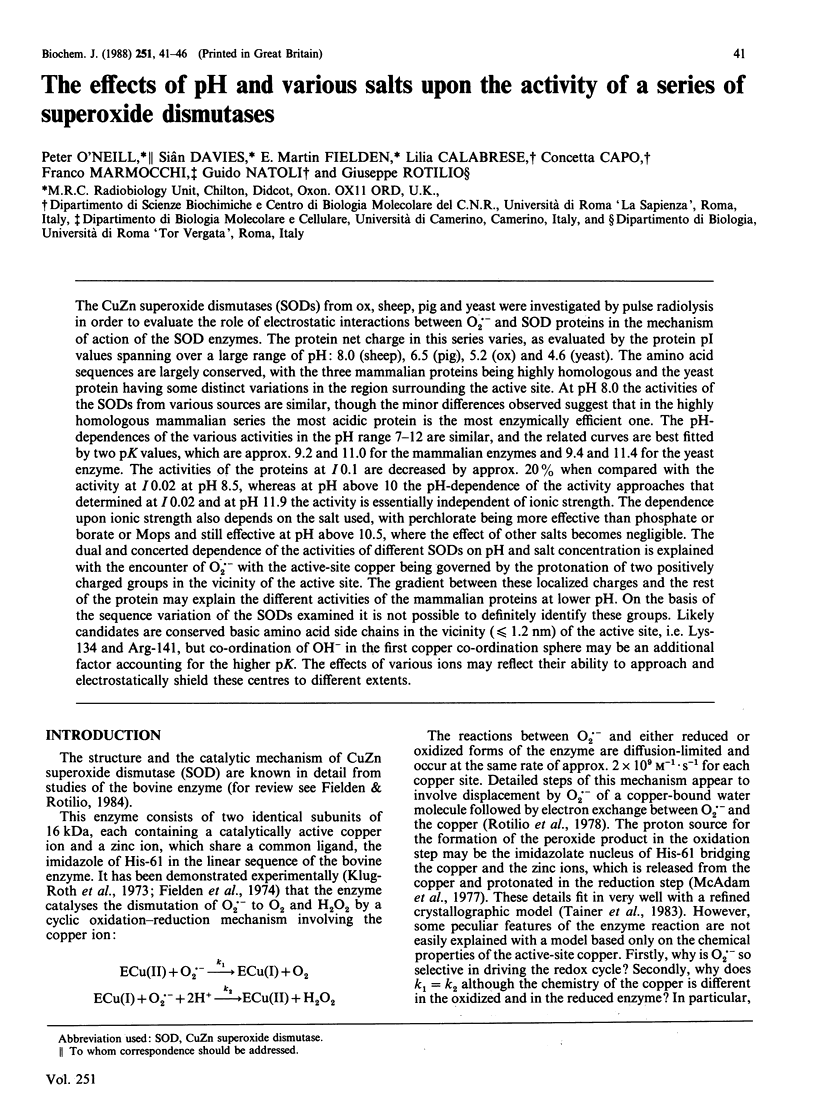
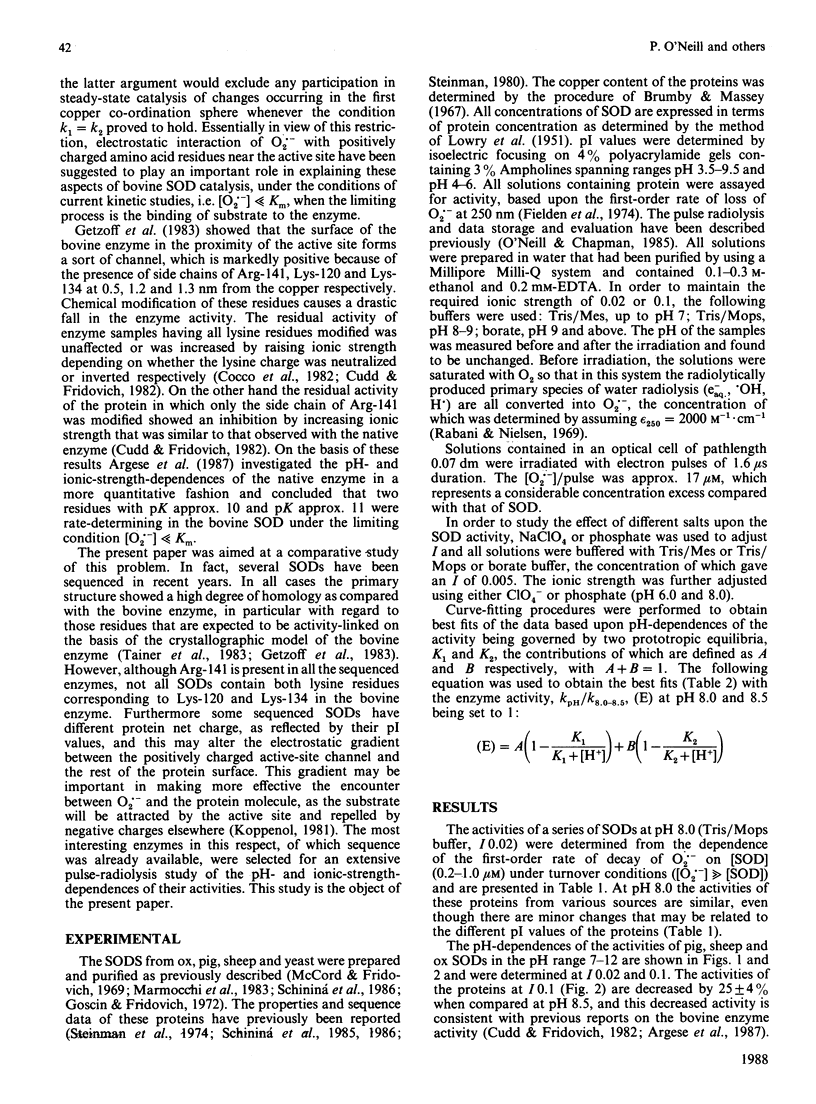
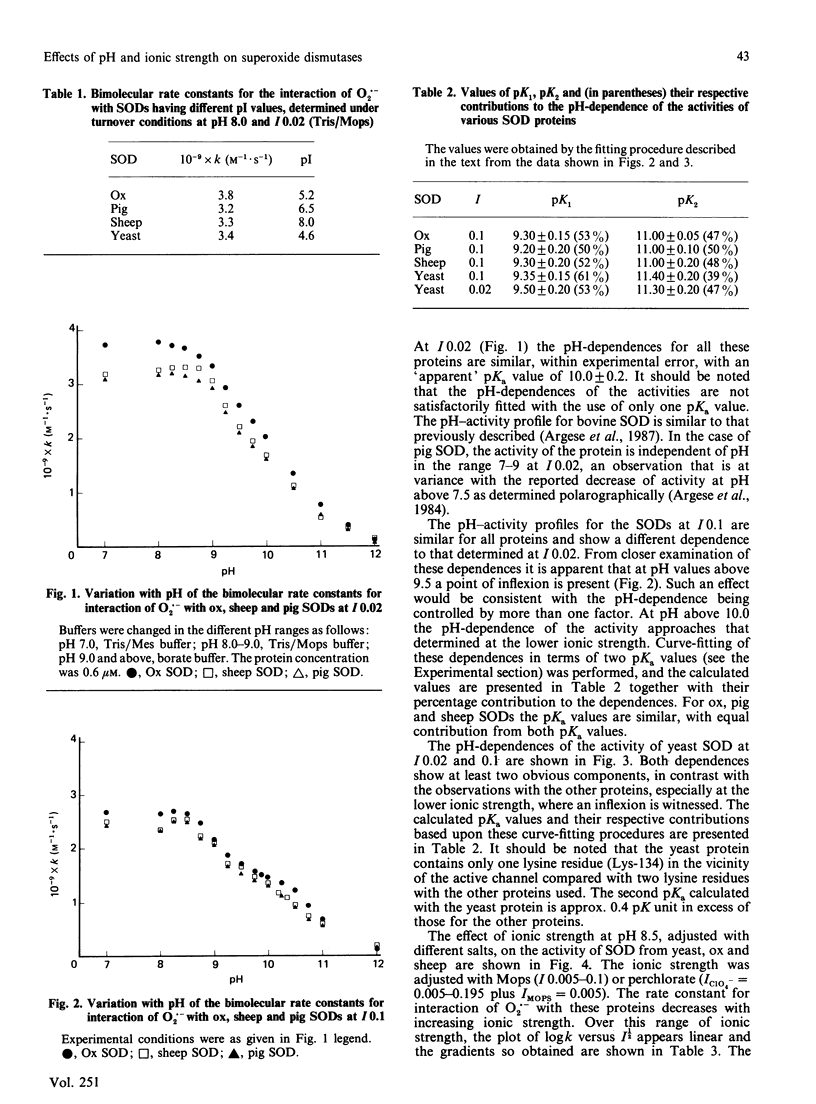
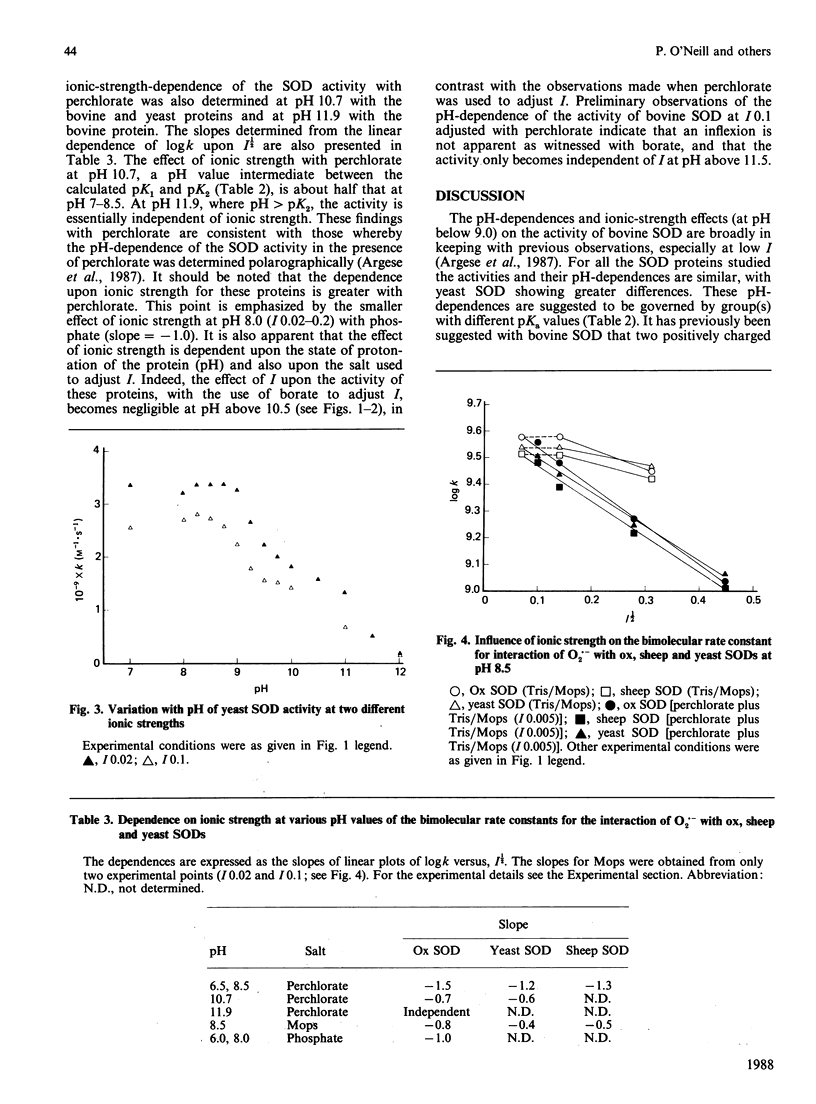
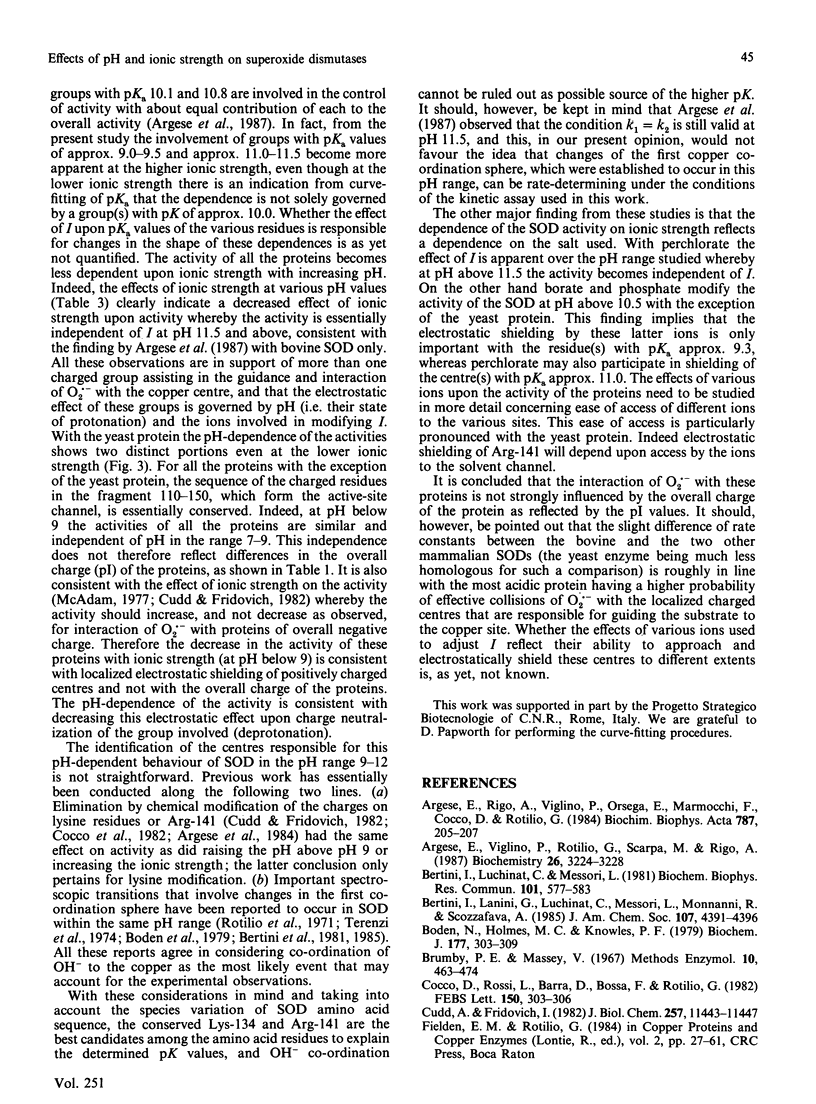
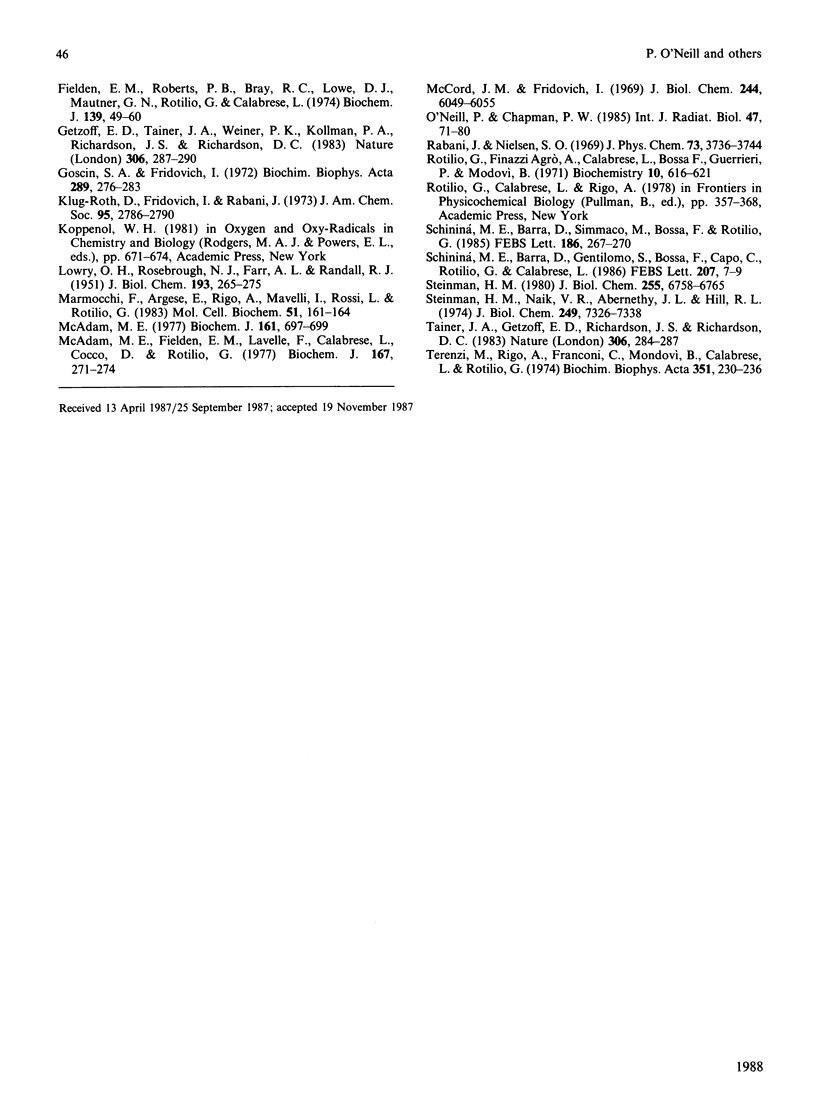
Selected References
These references are in PubMed. This may not be the complete list of references from this article.
- Argese E., Viglino P., Rotilio G., Scarpa M., Rigo A. Electrostatic control of the rate-determining step of the copper, zinc superoxide dismutase catalytic reaction. Biochemistry. 1987 Jun 2;26(11):3224–3228. doi: 10.1021/bi00385a043. [DOI] [PubMed] [Google Scholar]
- Bertini I., Luchinat C., Messori L. A water 17O NMR study of the pH dependent properties of superoxide dismutase. Biochem Biophys Res Commun. 1981 Jul 30;101(2):577–583. doi: 10.1016/0006-291x(81)91298-5. [DOI] [PubMed] [Google Scholar]
- Boden N., Holmes M. C., Knowles P. F. Properties of the cupric sites in bovine superoxide dismutase studied by nuclear-magnetic-relaxation measurements. Biochem J. 1979 Jan 1;177(1):303–309. doi: 10.1042/bj1770303. [DOI] [PMC free article] [PubMed] [Google Scholar]
- Cocco D., Rossi L., Barra D., Bossa F., Rotilio G. Carbamoylation of Cu,Zn-superoxide dismutase by cyanate. Role of lysines in the enzyme action. FEBS Lett. 1982 Dec 27;150(2):303–306. doi: 10.1016/0014-5793(82)80756-4. [DOI] [PubMed] [Google Scholar]
- Cudd A., Fridovich I. Electrostatic interactions in the reaction mechanism of bovine erythrocyte superoxide dismutase. J Biol Chem. 1982 Oct 10;257(19):11443–11447. [PubMed] [Google Scholar]
- Fielden E. M., Roberts P. B., Bray R. C., Lowe D. J., Mautner G. N., Rotilio G., Calabrese L. Mechanism of action of superoxide dismutase from pulse radiolysis and electron paramagnetic resonance. Evidence that only half the active sites function in catalysis. Biochem J. 1974 Apr;139(1):49–60. doi: 10.1042/bj1390049. [DOI] [PMC free article] [PubMed] [Google Scholar]
- Getzoff E. D., Tainer J. A., Weiner P. K., Kollman P. A., Richardson J. S., Richardson D. C. Electrostatic recognition between superoxide and copper, zinc superoxide dismutase. Nature. 1983 Nov 17;306(5940):287–290. doi: 10.1038/306287a0. [DOI] [PubMed] [Google Scholar]
- Goscin S. A., Fridovich I. The purification and properties of superoxide dismutase from Saccharomyces cerevisiae. Biochim Biophys Acta. 1972 Dec 7;289(2):276–283. doi: 10.1016/0005-2744(72)90078-2. [DOI] [PubMed] [Google Scholar]
- Klug-Roth D., Fridovich I., Rabani J. Pulse radiolytic investigations of superoxide catalyzed disproportionation. Mechanism for bovine superoxide dismutase. J Am Chem Soc. 1973 May 2;95(9):2786–2790. doi: 10.1021/ja00790a007. [DOI] [PubMed] [Google Scholar]
- LOWRY O. H., ROSEBROUGH N. J., FARR A. L., RANDALL R. J. Protein measurement with the Folin phenol reagent. J Biol Chem. 1951 Nov;193(1):265–275. [PubMed] [Google Scholar]
- Marmocchi F., Argese E., Rigo A., Mavelli I., Rossi L., Rotilio G. A comparative study of bovine, porcine and yeast superoxide dismutases. Mol Cell Biochem. 1983;51(2):161–164. doi: 10.1007/BF00230402. [DOI] [PubMed] [Google Scholar]
- McAdam M. E. A consideration of the effects of added solutes on the activity of bovine superoxide dismutase. Biochem J. 1977 Mar 1;161(3):697–699. doi: 10.1042/bj1610697. [DOI] [PMC free article] [PubMed] [Google Scholar]
- McAdam M. E., Feilden E. M., Lavelle F., Calabrese L., Cocco D., Rotilio G. The involvement of the bridging imidazolate in the catalytic mechanism of action of bovine superoxide dismutase. Biochem J. 1977 Oct 1;167(1):271–274. doi: 10.1042/bj1670271. [DOI] [PMC free article] [PubMed] [Google Scholar]
- McCord J. M., Fridovich I. Superoxide dismutase. An enzymic function for erythrocuprein (hemocuprein). J Biol Chem. 1969 Nov 25;244(22):6049–6055. [PubMed] [Google Scholar]
- O'Neill P., Chapman P. W. Potential repair of free radical adducts of dGMP and dG by a series of reductants. A pulse radiolytic study. Int J Radiat Biol Relat Stud Phys Chem Med. 1985 Jan;47(1):71–80. doi: 10.1080/09553008514550101. [DOI] [PubMed] [Google Scholar]
- Rotilio G., Agrò A. F., Calabrese L., Bossa F., Guerrieri P., Mondovì B. Studies of the metal sites of copper proteins. Ligands of copper in hemocuprein. Biochemistry. 1971 Feb 16;10(4):616–621. doi: 10.1021/bi00780a011. [DOI] [PubMed] [Google Scholar]
- Schininà M. E., Barra D., Gentilomo S., Bossa F., Capo C., Rotilio G., Calabrese L. Primary structure of a cationic Cu,Zn superoxide dismutase. The sheep enzyme. FEBS Lett. 1986 Oct 20;207(1):7–10. doi: 10.1016/0014-5793(86)80003-5. [DOI] [PubMed] [Google Scholar]
- Schininà M. E., Barra D., Simmaco M., Bossa F., Rotilio G. Primary structure of porcine Cu,Zn superoxide dismutase. FEBS Lett. 1985 Jul 8;186(2):267–270. doi: 10.1016/0014-5793(85)80722-5. [DOI] [PubMed] [Google Scholar]
- Steinman H. M., Naik V. R., Abernethy J. L., Hill R. L. Bovine erythrocyte superoxide dismutase. Complete amino acid sequence. J Biol Chem. 1974 Nov 25;249(22):7326–7338. [PubMed] [Google Scholar]
- Steinman H. M. The amino acid sequence of copper-zinc superoxide dismutase from bakers' yeast. J Biol Chem. 1980 Jul 25;255(14):6758–6765. [PubMed] [Google Scholar]
- Tainer J. A., Getzoff E. D., Richardson J. S., Richardson D. C. Structure and mechanism of copper, zinc superoxide dismutase. Nature. 1983 Nov 17;306(5940):284–287. doi: 10.1038/306284a0. [DOI] [PubMed] [Google Scholar]
- Terenzi M., Rigo A., Franconi C., Calabrese L., Rotilio G., Mondovì B. pH dependece of the nuclear magnetic relaxation rate of solvent water protons in solutions of bovine superoxide dismutase. Biochim Biophys Acta. 1974 Jun 7;351(2):230–236. doi: 10.1016/0005-2795(74)90185-8. [DOI] [PubMed] [Google Scholar]


